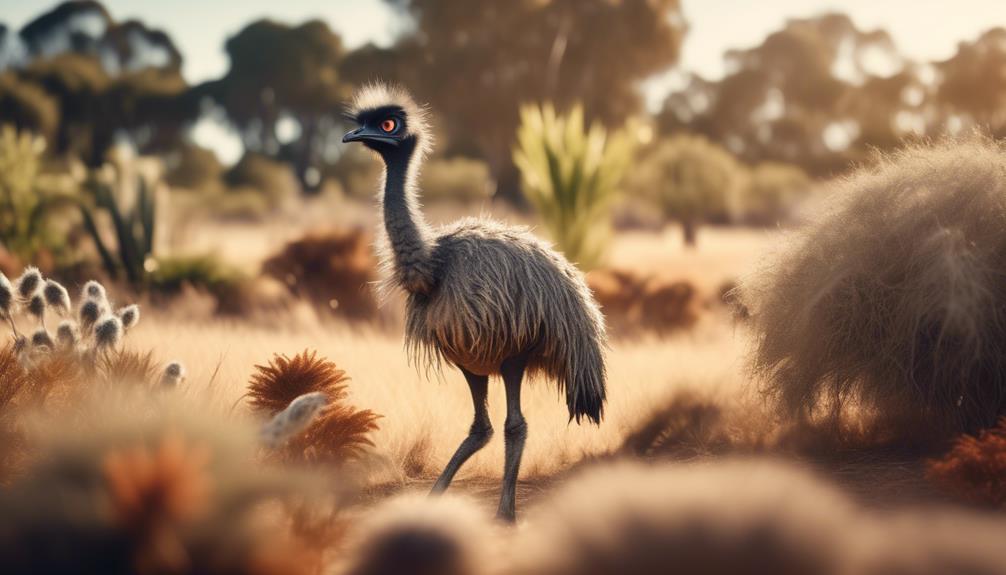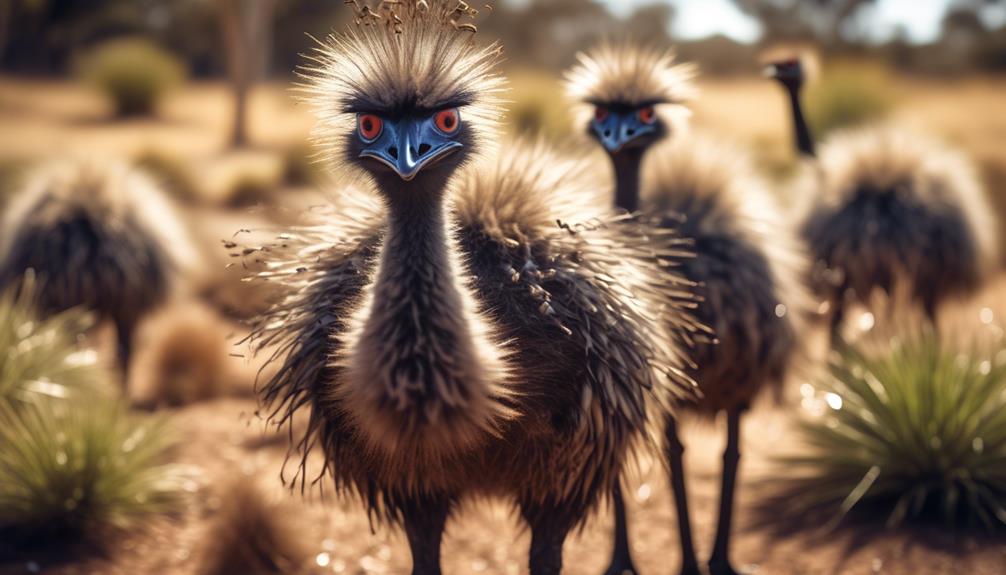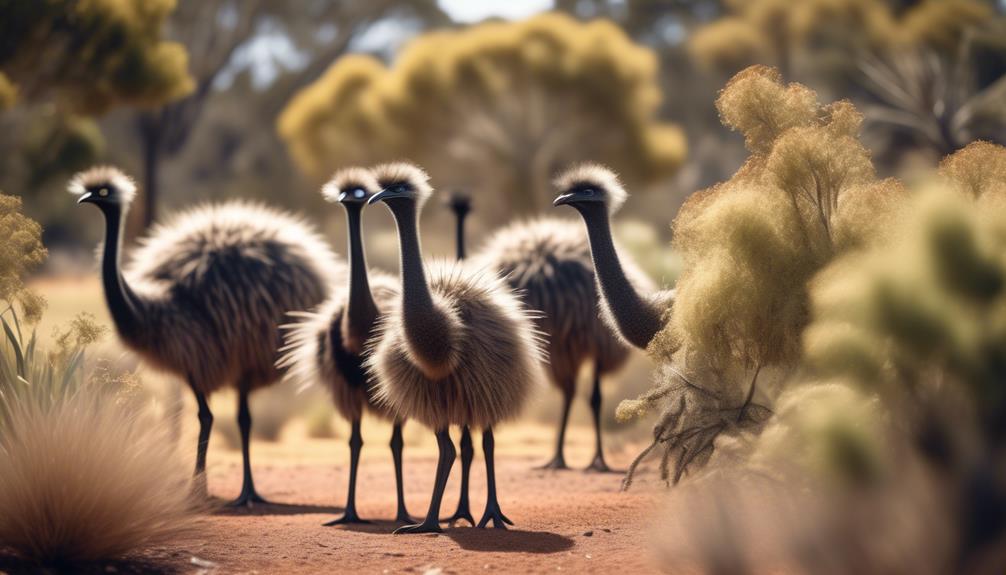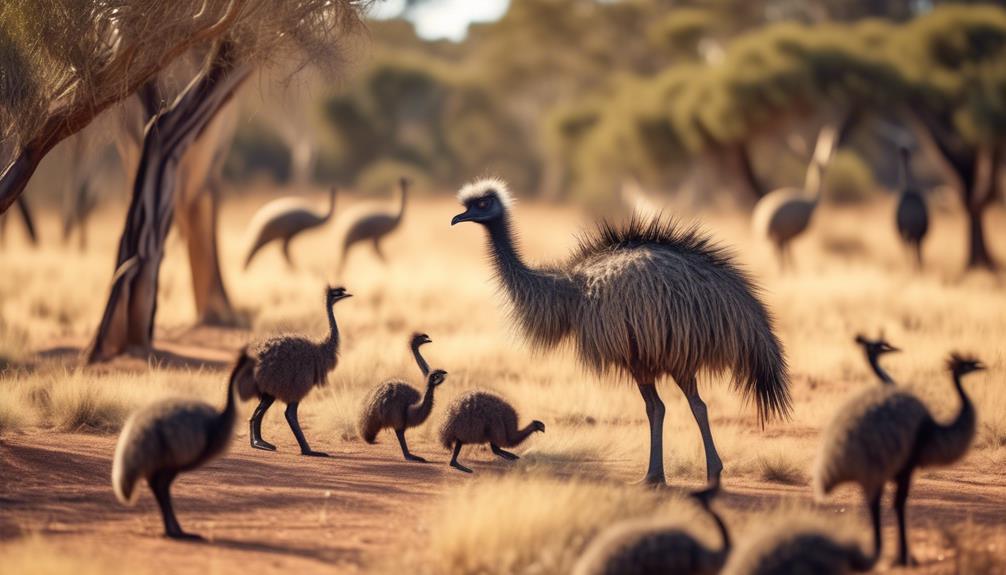
Have you ever wondered about the fascinating role of emus in Australian ecosystems? These unique flightless birds, known for their distinctive appearance and curious behaviors, play a crucial part in maintaining the delicate balance of their habitats.
From their foraging practices to their impact on plant regeneration, emus have a significant influence on the overall health and diversity of the Australian landscape.
In this discussion, we will explore the various ways in which emus contribute to the intricate web of life, shedding light on their vital role in sustaining the ecosystems they call home.
So, let's dive into the intriguing world of emus and discover the secrets they hold within.
Emus as Seed Dispersers

Emus play a crucial role in Australian ecosystems as active seed dispersers. Their foraging behaviors contribute significantly to the dispersal of seeds, which in turn affects the dynamics of plant populations and the overall structure of ecosystems. Emus are particularly important in fire ecology, as they can disperse seeds from fire-resistant plants, ensuring their survival and regeneration after a fire event.
Research has shown that emus are attracted to burnt areas, likely due to the increased availability of food and the reduced competition for resources. As they move through these fire-affected areas, emus consume fruits and seeds from a variety of plants. The seeds ingested by emus are then dispersed through their droppings, allowing for potential colonization of new areas.
In addition to their role in fire ecology, emus also contribute to soil nutrient cycling. By consuming fruits and seeds, emus aid in the breakdown of organic matter, facilitating the release of nutrients back into the soil. The deposition of nutrient-rich droppings further enhances soil fertility, benefiting the growth and development of plants in the ecosystem.
Foraging Behaviors of Emus
The foraging behaviors of emus contribute significantly to seed dispersal and soil nutrient cycling, playing a crucial role in the dynamics and structure of Australian ecosystems. Emus are opportunistic foragers, employing various strategies to obtain a diverse diet that consists primarily of plant material, but also includes insects and small vertebrates.
Here are three key foraging strategies and diet preferences of emus:
- Grazing: Emus are well-adapted to grazing on grasses and herbs, using their sharp beaks to pluck vegetation close to the ground. They prefer tender shoots and leaves, which provide them with essential nutrients and moisture.
- Seed consumption: Emus are important seed dispersers, as they consume a wide variety of plant seeds. Their strong digestive system allows them to break down tough seed coats, aiding in seed germination. This behavior helps maintain plant diversity and promotes the regeneration of vegetation in Australian ecosystems.
- Insect predation: While emus primarily rely on plant material, they also opportunistically consume insects and small vertebrates. This behavior not only supplements their diet with protein but also controls insect populations, contributing to the overall balance of the ecosystem.
Understanding the foraging strategies and diet preferences of emus is crucial for comprehending their ecological impact. By promoting seed dispersal, nutrient cycling, and insect control, emus play a vital role in shaping the structure and functioning of Australian ecosystems.
Impact of Emus on Plant Regeneration

The impact of emus on plant regeneration is evident through their role in seed dispersal and germination. Emus play a crucial part in maintaining the biodiversity and sustainability of Australian ecosystems. By consuming various plant species, emus aid in the dispersal of seeds through their digestive tract. As emus move across vast territories, they deposit seeds in their droppings, contributing to the dispersal of plant species over long distances. This dispersal process not only helps plants colonize new areas but also enhances genetic diversity within populations.
Furthermore, emus have a positive impact on soil fertility. As they forage on plants, they disturb the soil, allowing for the incorporation of organic matter and nutrients into the topsoil. Their droppings act as a natural fertilizer, providing essential nutrients that promote plant growth and regeneration. This nutrient cycling facilitated by emus contributes to the overall health and productivity of the ecosystem.
Emus also play a vital role in fire ecology. Their foraging behaviors create a mosaic pattern in the landscape, leading to a heterogeneous distribution of vegetation. This diverse vegetation structure, characterized by patches of different ages and heights, acts as natural firebreaks and reduces the risk of widespread, intense fires. Consequently, emus indirectly influence the regeneration of plant communities after fire events by promoting a more resilient and diverse landscape.
Nutrient Cycling Facilitated by Emus
Through their foraging behaviors and digestive processes, emus contribute to the nutrient cycling in Australian ecosystems. These large flightless birds play a crucial role in enriching the soil and promoting plant diversity.
Here are three ways in which emus facilitate nutrient cycling:
- Seed dispersal: Emus consume a wide variety of plant material, including fruits, seeds, and leaves. As they move through the landscape, they disperse these seeds through their droppings, aiding in the spread of plant species. This dispersal mechanism increases the chances of successful germination and establishment of new plants, enhancing overall plant diversity.
- Nutrient deposition: Emus have a unique digestive system that allows them to break down tough plant material. As they consume plants, their digestive processes break down cellulose and release nutrients into their droppings. These droppings, also known as emu scats, serve as a rich source of nutrients such as nitrogen, phosphorus, and potassium. When these scats decompose, they enrich the soil, providing essential nutrients for plant growth.
- Tilling the soil: Emus use their strong legs and large feet to forage and dig for food. In the process, they disturb the soil surface, promoting aeration and nutrient mixing. This tilling action helps to break up compacted soil, allowing water and air to penetrate more easily. It also aids in the decomposition of organic matter, further enriching the soil and creating favorable conditions for plant growth.
Emus and Their Adaptation to Diverse Habitats

Emus demonstrate remarkable adaptability to a wide range of habitats, showcasing their ability to thrive in diverse environmental conditions. These large flightless birds have evolved various reproductive strategies to ensure their survival, further enhancing their adaptability. Emus are polygynous, with males attracting multiple females during the breeding season. The females then lay their eggs in a communal nest, which the male incubates and raises the chicks alone. This strategy increases the chances of successful reproduction in unpredictable and harsh environments.
Furthermore, emus play a significant role in fire ecology. They have adapted to fire-prone habitats by altering their behavior and habitat selection. Emus are known to actively seek out recently burned areas, as these provide them with abundant food resources. They consume the regenerating vegetation and help control the post-fire plant composition. By doing so, emus contribute to the maintenance of a diverse plant community and the prevention of dominance by fire-adapted species.
To provide a visual representation of emus' adaptability to diverse habitats, consider the following table:
| Habitat Type | Adaptation Strategy |
|---|---|
| Arid Deserts | Ability to go long periods without water |
| Forested Areas | Agile runners and navigators through dense vegetation |
| Coastal Regions | Excellent swimmers and divers |
| Grasslands | Camouflage and blending into the surroundings |
| Alpine Environments | Thick plumage for insulation against cold temperatures |
Emus' ability to adapt to diverse habitats underscores their ecological importance and their ability to contribute to and thrive in Australian ecosystems.
Long-Distance Travel Patterns of Emus
Long-distance travel patterns of emus have been studied extensively, revealing fascinating insights into their migratory behavior and navigation abilities. Here are three key aspects of emus' migration patterns and mating behavior:
- Seasonal Movements: Emus are known to undertake long-distance journeys in search of food and suitable breeding grounds. During the breeding season, they travel to areas with abundant resources and suitable nesting sites. This seasonal movement ensures that emus have access to the necessary resources for successful reproduction.
- Navigation Abilities: Emus possess remarkable navigation abilities, allowing them to traverse vast distances with precision. They rely on a combination of visual cues, such as landmarks and the position of the sun, and an innate sense of direction to navigate their way. This remarkable navigational skill enables emus to return to the same breeding and feeding grounds year after year.
- Mating Behavior: Emus' migration patterns are closely linked to their mating behavior. Male emus travel long distances to find suitable mates and establish territories. They engage in elaborate courtship displays to attract females. Once a pair has formed, they remain together for the duration of the breeding season. The male takes on the responsibility of incubating the eggs while the female moves on to find another mate.
Understanding emus' migration patterns and mating behavior is crucial for the conservation and management of these iconic Australian birds. It allows us to appreciate their incredible adaptability and the vital role they play in maintaining the balance of ecosystems they inhabit.
Emus and Their Role in Maintaining Biodiversity

By participating in long-distance travel and exhibiting specific behaviors, emus play a fundamental role in maintaining the biodiversity of Australian ecosystems. Emus are known to travel vast distances in search of food, water, and suitable habitat. This extensive movement allows them to disperse seeds over large areas, aiding in the regeneration of vegetation and promoting plant diversity. As they consume a variety of plant material, including fruits and seeds, emus also facilitate the spread of different plant species by dispersing their seeds through their droppings.
Furthermore, emus contribute to maintaining biodiversity by influencing the balance of predator-prey relationships. Emus are known to prey on small animals such as insects, reptiles, and small mammals. By controlling the population of these prey species, emus help maintain a healthy balance within the ecosystem, preventing overgrazing and allowing other species to thrive.
In addition to their ecological significance, emus also play a role in mitigating the effects of climate change. Emus are well adapted to arid environments and can withstand extreme temperatures and drought conditions. Their presence in these regions contributes to the overall resilience of the ecosystem, as they help disperse seeds that are adapted to survive in such harsh conditions.
However, emus also face challenges in their role as biodiversity maintainers. Human-wildlife conflict, such as habitat destruction and collisions with vehicles, poses a threat to their population. Climate change also impacts the availability of suitable habitat and food sources for emus. Therefore, it's crucial to implement conservation measures that protect emus and ensure their continued contribution to maintaining biodiversity in Australian ecosystems.
Emus as Indicators of Ecosystem Health
An assessment of ecosystem health can be made by considering the presence and behavior of emus within a given ecosystem. These large flightless birds play an important role as predators in maintaining the balance of species within their habitats. By observing their interactions with other organisms, scientists can gain valuable insights into the overall health of the ecosystem.
Here are three ways in which emus serve as indicators of ecosystem health:
- Prey populations: Emus primarily feed on a variety of plant materials, but they also consume small animals and insects. A decline in emu populations may indicate a decrease in prey availability, suggesting potential disruptions in the food web.
- Habitat quality: Emus require vast areas of open grasslands and shrublands for foraging and nesting. Changes in emu behavior, such as altered migration patterns or nesting sites, may indicate habitat degradation due to factors like land use changes or climate change impacts.
- Climate change impacts: Emus are highly adaptable birds, but they may be affected by the changing climate. Monitoring changes in emu distribution and breeding behavior can provide insights into the impacts of climate change on ecosystems.
Interactions Between Emus and Other Wildlife Species

To further explore the role of emus as indicators of ecosystem health, it's crucial to examine their interactions with other wildlife species within their habitats.
Emus, being large and flightless birds, have unique interactions with both predators and prey. They're known to form mixed-species groups with other herbivores, such as kangaroos and wallabies, which increases their collective chances of detecting and avoiding predators. By sharing information about potential threats, emus and other herbivores contribute to the overall safety of their group.
In terms of their interactions with predators, emus have been observed engaging in territorial displays and vocalizations to deter potential threats. Their ability to run at high speeds also acts as an effective defense mechanism against predators. Additionally, emus have been observed utilizing their strong legs and sharp claws to defend themselves and their young from predators.
When it comes to their role in soil composition, emus have a significant impact. Through their feeding behaviors, emus help break down vegetation, contributing to the decomposition process. This process enriches the soil with organic matter and nutrients, making it more fertile for plant growth. Furthermore, the movement and scratching of emus' feet while foraging helps to loosen and aerate the soil, enhancing its structure and promoting better water infiltration.
Emus and Their Impact on Vegetation Structure
Emus play a significant role in shaping the vegetation structure within their habitats through their feeding behaviors and foraging patterns. Their impact on vegetation structure is influenced by their interactions with fire ecology and their ability to prevent soil erosion.
Emus have a unique relationship with fire ecology. They're known to consume various plants, including dry grasses and low-lying shrubs, which are highly flammable. By consuming these plants, emus reduce the fuel load in their habitats, making them less prone to intense fires. This behavior helps maintain a healthy vegetation structure and promotes the growth of fire-resistant plant species.
Emus also play a crucial role in preventing soil erosion. Their foraging behaviors involve scratching the ground with their powerful feet, which helps loosen the top layer of soil. This action aids in the breakdown of organic matter and promotes nutrient cycling. Additionally, emus' foraging patterns create small depressions in the soil, which act as catchment areas for rainfall. These depressions allow water to accumulate and infiltrate into the soil, reducing surface runoff and preventing erosion.
Conservation Considerations for Emus in Australian Ecosystems

Conservation considerations for emus in Australian ecosystems encompass a range of factors that must be taken into account to ensure the long-term sustainability of their populations. Effective conservation management strategies are essential for maintaining healthy emu populations and preserving the ecological balance in these ecosystems. Understanding the population dynamics of emus is crucial in developing these strategies.
To evoke an emotional response in the audience, let's look at a table showcasing the current population status of emus in different regions of Australia:
| Region | Population Status | Threat Level |
|---|---|---|
| Northern | Declining | High |
| Eastern | Stable | Moderate |
| Western | Increasing | Low |
| Southern | Stable | Moderate |
| Central | Declining | High |
The table highlights the varying population dynamics and threat levels faced by emus in different regions. It emphasizes the need for targeted conservation efforts to address the specific challenges faced by each population.
Conservation management should focus on habitat protection, reducing threats from habitat loss, predation, and human activities such as hunting. Monitoring and research programs are essential for gathering data on emu populations, identifying key threats, and implementing effective conservation measures.
Frequently Asked Questions
Are Emus the Only Birds That Contribute to Seed Dispersal in Australian Ecosystems?
Emus are not the only birds that contribute to seed dispersal in Australian ecosystems. Other birds, such as cockatoos and pigeons, also play a role. However, emus have a unique diet and behavioral patterns that make them significant seed dispersers.
How Do Emus Locate and Access Food Sources in Their Habitats?
To locate and access food sources in their habitats, emus use their foraging behavior and feeding habits. They employ a variety of strategies, such as probing the ground with their beaks and consuming a wide range of plant material.
What Are the Long-Term Effects of Emus on the Regeneration of Plant Species?
Emus play a significant role in the regeneration of plant species. They aid in seed dispersal through their consumption of fruits and subsequent defecation. This promotes the growth and diversity of vegetation in Australian ecosystems.
How Do Emus Contribute to Nutrient Cycling in Their Ecosystems?
Emus play a vital role in nutrient cycling within their ecosystems. They contribute to the process by consuming plant material and depositing nutrient-rich droppings, which then fertilize the soil and aid in the regeneration of plant species.
Do Emus Have Any Specific Adaptations That Allow Them to Thrive in Diverse Habitats?
Emus have specific adaptations that enable them to thrive in diverse habitats. These include their long legs for running, sharp eyesight for spotting predators, and a specialized digestive system for consuming a wide variety of plant matter. Emu habitat selection is influenced by factors such as food availability and shelter.
Conclusion
In conclusion, the role of emus in Australian ecosystems is crucial for seed dispersal, nutrient cycling, and vegetation structure. Their foraging behaviors and adaptation to diverse habitats make them valuable indicators of ecosystem health.
Interactions between emus and other wildlife species further contribute to the balance of the ecosystem. Conservation efforts should consider the significant impact of emus on plant regeneration and the overall biodiversity of Australian ecosystems.
Further research and monitoring are needed to fully understand and protect the important role of emus in these ecosystems.





